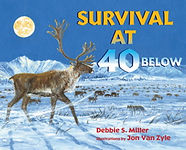Debbie S. Miller
De
Survival at 40 Below:
Featured Arctic Animals
These are some of the animals that survive Alaska's long winters. Click on the play button below each picture to hear their sounds.

Willow Ptarmigan

Wood Frog





Wolf
Caribou
Muskox
Ground Squirrel
Survival at 40 Below is a book that describes some of the amazing adaptations of arctic animals for winter survival. This story takes place in Gates of the Arctic National Park, a place that I've explored on foot during the summer. Thanks to the Park's artist-in-residence program, I hiked 75 miles through stunning wilderness where I encountered many of the animals that are featured in Survival at 40 Below, illustrated by Alaska wildlife artist, Jon Van Zyle. Above the Arctic Circle, animals must prepare for the extreme cold and long winters. Snow covers the ground from October until May, and the average temperature is below 32 degrees F. Each species has developed successful adaptations in order to survive temperatures that can drop to 40, 50, 60, even 70 degrees below zero!
Imagine for a moment what it would be like to be a wood frog living near the Arctic Circle. This incredible frog is frozen for most of the year beneath the snow and forest duff. A living frogsicle! Some animals are very active during the winter, such as wolves and caribou. Other animals, such as the Arctic ground squirrel and grizzly bear, conserve energy as they rest in their burrows and dens. Through my research and interviews with scientists I learned that animals of the Arctic have unusual and unique ways of combating and escaping the cold.
These are some of the animals that I studied to write the book Survival at 40 Below. The beautiful pictures of the wolf, musk oxen, Arctic ground squirrel, and the willow ptarmigan were taken by noted Alaska photographer Patrick Endres. Patrick is a talented landscape and wildlife photographer who was my canoe partner on an arctic expedition. Thanks to Patrick for sharing his pictures. Visit Patrick's Alaska Photo Graphics to see more incredible Alaska photography. In addition to seeing the animals, you can also hear their voices thanks to the recording work of Richard Nelson, a friend who loves spending time observing wild animals and recording their voices and natural sounds. Thanks to Nels for sharing nature's music and the lives of Alaska's animals with all of us. To hear more sounds and stories from the wilds visit Encounters.


Australian Magpie

Emu
Survival at 120 Above:
Featured Desert Animals
These are some of the animals that survive in Australia's Simpson Desert. Click on the play button below each picture to hear their sounds.



Dingo
Boobook Owl
Australian Raven
Survival at 120 Above is the sequel to Survival at 40 Below. This book describes some of the amazing adaptations of animals that live in Australia’s Simpson Desert. In April, 2010, I traveled to this stunning red desert with a dozen scientists from the University of Sydney. As a volunteer, I helped researchers capture, weigh, measure, and release many different marsupials and reptiles. I felt so lucky to hold animals, such as the thorny devil, in the palm of my hand. Imagine sleeping in a tent that is surrounded by a sea of brick-red sand as soft as velvet. As I awoke each morning, there were new sets of tracks lacing the sand dunes. Sometimes we found the dog-like tracks of dingos, or tiny hopping mouse tracks, or the curving trails of those big lizards known as sand goannas. The desert sand was alive with stories showing us all the activity that occurred in the coolness of night while we slept.
During the day the temperatures were scorching hot so this was our rest time. We read books and field guides about the animals that we discovered in the shade of gidgee trees. Most of the animals also escaped the afternoon sun by resting in their cool, underground burrows.
I took more than 600 photographs during my stay in the Simpson Desert. These pictures helped Jon Van Zyle create the beautiful, realistic paintings that are in the book. I also gave him some of the desert’s red sand which he used to match the red color of his paint. He even mixed some of the sand into his paint!
In addition to seeing these desert animals, you can also hear some of the voices of the birds that I saw while traveling through New South Wales and southern Queensland. The birds of Australia have dazzling colors and amazing voices that I’ll never forget. Thanks to Richard Nelson for sharing his wonderful recordings of these animals.


